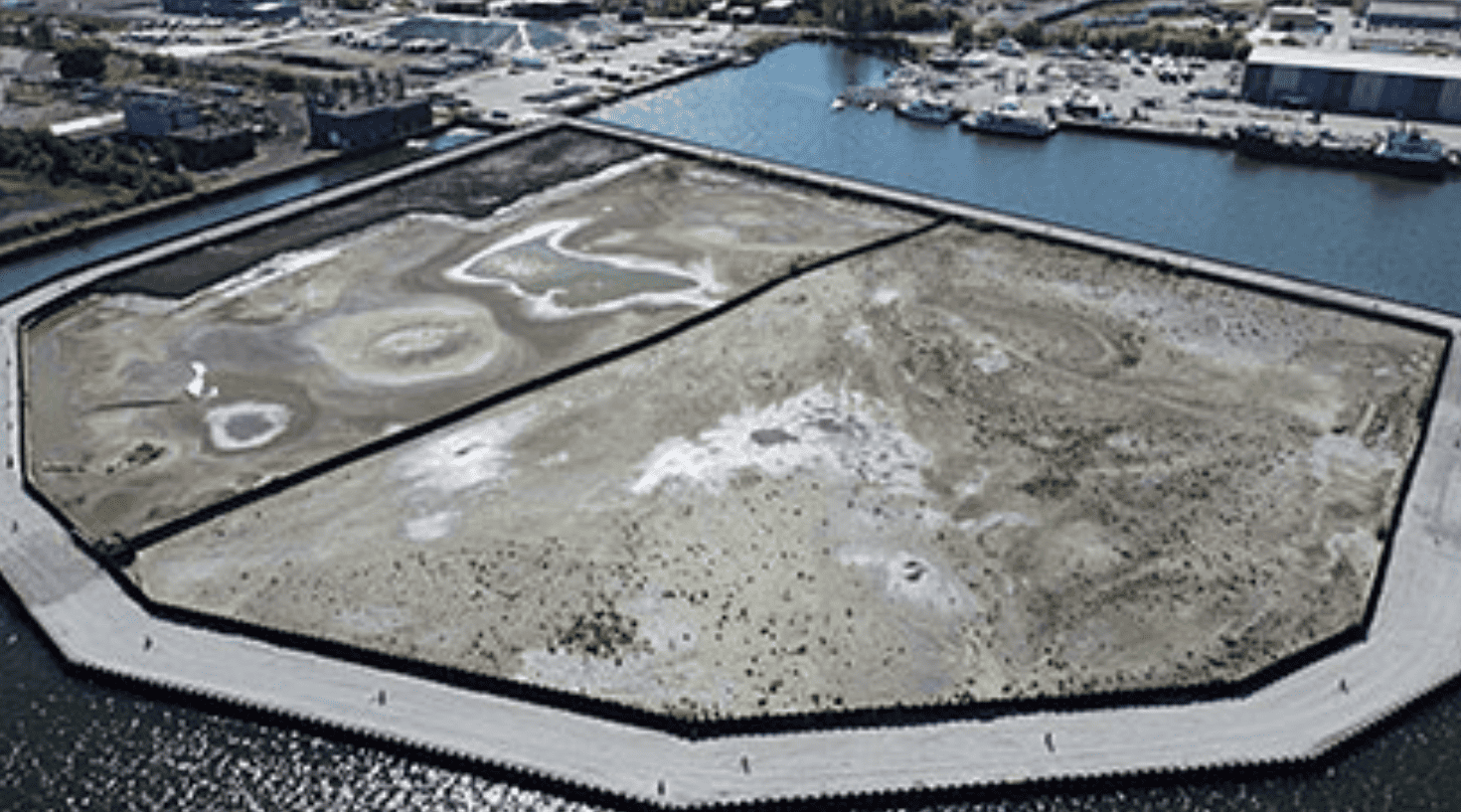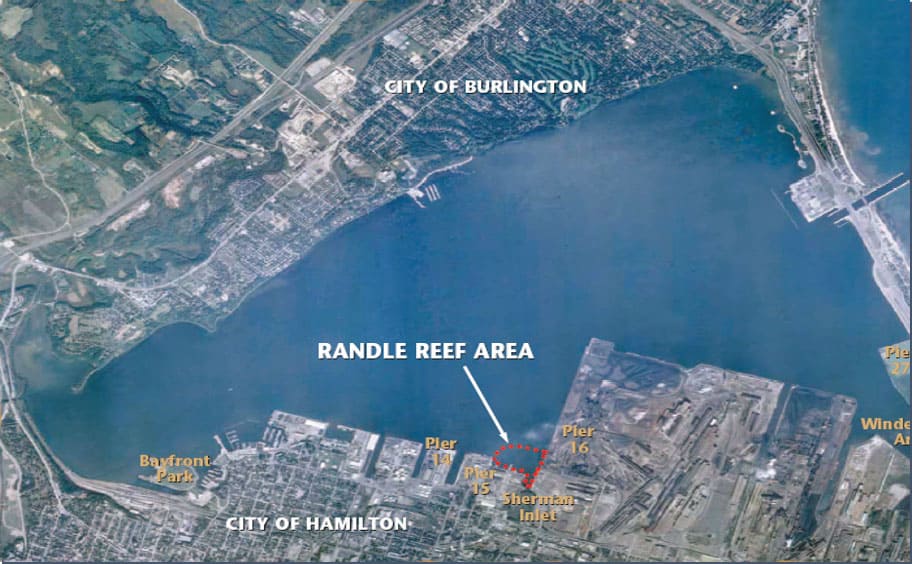Massive cleanup of Randle Reef in Hamilton Harbour reaches final stage
Published September 7, 2023 at 5:56 pm

The last stage of a project to clean up contaminated Randle Reef has begun with the awarding of a $29.2-million contract to a B.C. company
— considered one of the most significant steps to improve water quality along with fish and wildlife habitat in Hamilton Harbour.
The site has been described as being the size of about 120 football fields, or about 60 hectares.
Environment and Climate Change Canada announced in a press release on Sept. 6 that the federal government granted Milestone Environmental Contracting Inc. the construction contract for the project’s third and final phase after a competitive bidding process.
For the project, a 6.2-hectare engineered containment facility was to be built on top of the most contaminated sediment. The remaining sediment was to be placed in the facility, whose inner and outer walls were to be “sealed creating an impermeable barrier,” according to the project’s website. As part of the third and final step, the company will install a multi-layered environmental cap, which involves putting a cover over contaminants to isolate them.
“Addressing the contamination will be a significant milestone for Hamilton and allow rejuvenation of our natural environment,” said Filomena Tassi, member of Parliament for Hamilton West—Ancaster—Dundas and minister responsible for the Federal Economic Development Agency for Southern Ontario, in a statement. “This next step of the project brings us closer to a new chapter for Hamilton Harbour so that we can continue to grow our Ambitious City and protect our environment.”

COURTESY OF THE BAY AREA RESTORATION COUNCIL
Company responsible for work on final phase partners with Indigenous community
With costs exceeding $150 million, the Randle Reef remediation project is a joint initiative of the federal and provincial governments as well as the City of Hamilton, Halton Region, the City of Burlington, the Hamilton-Oshawa Port Authority and Hamilton steelmaker Stelco.
The feds and the province each contributed a third of the money and local partners funded the remaining third.
“This project is absolutely vital to the cleaning up of Burlington Bay (the former name of Hamilton Harbour) and ensuring we have a cleaner, healthier, and safer environment in our Great Lakes,” said Karina Gould, Burlington MP and leader of the government in the House of Commons, in a statement. “Burlingtonians are proud of our lakefront community — this project is contributing to continuing our proud maritime tradition and will play a key role in advancing economic development and a healthier environment for our communities.”
Partnering with Mississaugas of the Credit Business Corporation, Milestone said it has committed to sub-contracting more than 10 per cent of project work to an Indigenous business.
“Our Nation is pleased that Canada has prioritized the remediation of the Randle Reef site and has set this important precedent for the Mississaugas of the Credit First Nation, and our business corporation, to benefit from economic activity on our Traditional Territory,” said Gimaa (Chief) Stacey LaForme of Mississaugas of the Credit First Nation, in a statement.
The final stage is set to be done in 2025. After its completion, the Hamilton-Oshawa Port Authority will be responsible for the engineered containment facility and “will provide valuable port lands for the community,” according to the press release.
“Each stage that is completed is another step toward protecting and improving our water, the environment, and our health,” said Burlington Mayor Marianne Meed Ward. “I am eagerly looking forward to the completion of this project and the remediation of one of Canada’s most contaminated sediment sites.”
Randle Reef was once Canada’s biggest contaminated Great Lakes site
According to the federal government, the port lands on the Randle Reef remediated site could generate $168 million in economic benefits for the local community through jobs, business development and tourism.
Hamilton Harbour is expected to see improved shipping and port facilities, recreational opportunities and the transformation of the Harbour community as “a clean and progressive place to live and work.”
“Millions of Canadians source their drinking water from the Great Lakes, and restoring the water quality and ecosystem health of these magnificent lakes contributes to restoring our communities,” said Steven Guilbeault, minister of environment and climate change, in a statement. “The Randle Reef Project is a successful example of governments, local partners, and stakeholders working together to protect our fresh water, which is critical to the health and well-being of our environment, communities, and economy.”
Randle Reef, located in the southwest corner of Hamilton Harbour, has a history of industrial contamination for more than 150 years. During the first two stages of the cleanup, over 615,000 cubic metres of contaminated sediment was managed, according to the federal government.
Once the biggest contaminated sediment site on the Canadian side of the Great Lakes, Randle Reef is part of Hamilton Harbour on Lake Ontario. Randle Reef was identified as an “area of concern” under the Canada–US Great Lakes Water Quality Agreement in 1987. Areas of concern are those within the Great Lakes that have suffered “high levels” of environmental damage.
The federal government had announced this past spring $420 million over 10 years to speed up the restoration and protection of the Great Lakes. It aims to complete the cleanup of 12 out of 14 remaining Canadian areas of concern in the Great Lakes by 2030, and all 14 of them within 15 years.
inthehammer's Editorial Standards and Policies advertising





